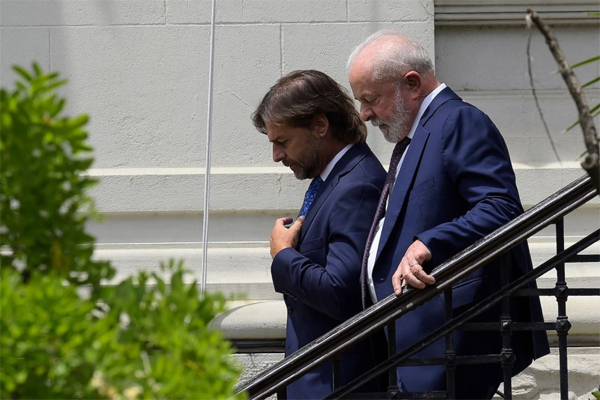Members of the customs union Mercosur pledge to ease internal trade and explore new deals abroad.

By Catherine Osborn
A Neighborhood That Means Business?
Trade was high on the agenda of Brazilian President Luiz Inácio Lula da Silva’s first overseas trip of his term to Argentina and Uruguay this week. The former jaunt included Tuesday’s summit of the Community of Latin American and Caribbean States (CELAC) in Buenos Aires.
During Lula’s visit to Argentina on Monday, Brazilian Finance Minister Fernando Haddad announced that a government-owned bank would issue new credit lines for Brazilian companies to export goods to Argentina, and Lula and Argentine President Alberto Fernández announced that the two countries would study a financial mechanism to conduct bilateral trade without converting transactions to U.S. dollars, which Argentina sorely lacks.
While Lula and Fernández referred to this mechanism as a “common currency” in an op-ed last weekend, Haddad has since clarified that the leaders are considering a common unit of account for trade operations rather than a currency that would replace the Brazilian real and Argentine peso.
Then, at the CELAC summit the next day, leaders from center-right Uruguayan President Luis Lacalle Pou to leftist Colombian President Gustavo Petro called for Latin America to trade more internally.
And on Wednesday, during meetings in Uruguay’s capital of Montevideo, Lula proposed talks on “modernizing” the Mercosur customs union, an “urgent” approval to its draft trade deal with the European Union, and subsequent exploration a free trade agreement with China. Mercosur’s rules prohibit any one of its members—Argentina, Brazil, Paraguay, and Uruguay (Venezuela is suspended)—from making trade agreements without the others’ consent, but Lacalle Pou has been studying the possibility of an independent bilateral trade deal between Montevideo and Beijing.
Altogether, the week’s events were an adrenaline shot to Mercosur—and a signal that Brazil’s return to regional engagement may address long-standing criticism that South America is not living up to its potential on foreign trade.
Lacalle Pou argues that Mercosur’s slowness to make deals with new markets is holding its members back from trade opportunities. The potential EU deal has been in the works for more than 20 years and was stalled further under former Brazilian President Jair Bolsonaro over EU objections to his environmental record. Last December, following Lula’s election, European Commission President Ursula von der Leyen said in a speech that the EU had a “unique window of opportunity” to approve the deal.
It appears that Lacalle Pou’s vocal complaints about Mercosur have affected Lula’s stance on the EU deal, former Brazilian diplomat Rubens Barbosa told Foreign Policy. “During the campaign, [Lula’s] Workers’ Party had said they wanted to reopen negotiations on the agreement.” On Wednesday, Lula said simply he hoped to sign it.
But while Uruguay’s haste to negotiate a trade deal with China—and Lula’s pledge that Mercosur will consider one—resolves a short-term rift, it also sets the customs union up with a longer-term dilemma.
Lula’s foreign affairs advisor is among policymakers who have warned that shrinking industrial sectors have become a problem for South American countries in recent years, as industrial sector jobs are often better paid than the jobs in raw materials extraction and the service sector that are replacing them. The big boom in South American commodities exports since the turn of the century is intertwined with the continent’s growing trade with China, which tends to buy raw materials from South American countries and in turn sells them manufactured goods.
For Brazil, that means China’s rise has not only increased the role of commodities in Brazilian exports but also led Chinese-manufactured goods to replace Brazilian-manufactured goods in other markets, such as Argentina. In 2021, China overtook Brazil as the top exporter to Argentina, despite the fact that its goods are hit by a tariff when they enter Mercosur.
A 2019 study from the Brazilian government’s Institute of Applied Economic Research modeled a potential Brazil-China trade deal and concluded that it would increase Brazil’s trade flow with China overall but reduce Brazilian employment in manufacturing.
Lula’s overtures on bilateral trade with Argentina “could help Brazil export more manufactured goods,” José Augusto de Castro of the Brazilian Foreign Trade Association (AEB) told Foreign Policy, as Argentina is a top destination for Brazilian-manufactured goods, such as cars. Brazilian exports to Argentina have been as high as $22.7 billion in 2011 but in 2022 totaled $15.3 billion, according to AEB. Government credit for exporters has been scarcer in recent years, Castro said, adding that Brazilian state support helps exporters do business in a country with as much economic uncertainty as Argentina.
A new mechanism for non-dollar-denominated trade could likewise increase commercial flows between Argentina and Brazil, Barbosa said. Though the system’s exact structure is yet to be negotiated, it’s expected that transactions “would be guaranteed by the two central banks,” inserting more trust into cross-border commerce.
But “there’s a limit” to how much government credit can be provided to exporters, economist Lia Valls Pereira of the Brazilian Center of International Relations told Foreign Policy. A boom in exports of Brazilian-manufactured goods requires a series of other reforms in education, infrastructure for transporting goods, and industrial policy, she said.
For the time being, a Mercosur-China deal is likely still years away, former Brazilian Foreign Trade Secretary Welber Barral told Foreign Policy. “Remember that simpler negotiations, like [Mercosur’s ongoing talks] with Canada, have already gone on for six years.”
Still, Lacalle Pou suggested in a press conference on Wednesday that he did not mean to delay the prospect of a Mercosur-China deal indefinitely. “Uruguay has its negotiations [with China],” he told reporters. “If there is a decision by Lula and the [Brazilian] government to advance with China, we can easily fold if that is what is really consistent with the needs of our country.”
Mercosur has been jolted out of its stasis.
________________________________________________________________________________
Catherine Osborn is the writer of Foreign Policy’s weekly Latin America Brief. She is a print and radio journalist based in Rio de Janeiro. Energiesnet.com does not necessarily share these views.
Editor’s Note: This article was originally published by FP, on January 27, 2023. All comments posted and published on EnergiesNet.com, do not reflect either for or against the opinion expressed in the comment as an endorsement of EnergiesNet.com or Petroleumworld.
Use Notice: This site contains copyrighted material the use of which has not always been specifically authorized by the copyright owner. We are making such material available in our efforts to advance understanding of issues of environmental and humanitarian significance. We believe this constitutes a ‘fair use’ of any such copyrighted material as provided for in section 107 of the US Copyright Law. In accordance with Title 17 U.S.C. Section 107. For more information go to: http://www.law.cornell.edu/uscode/17/107.shtml.
energiesnet.com 01 30 2023











